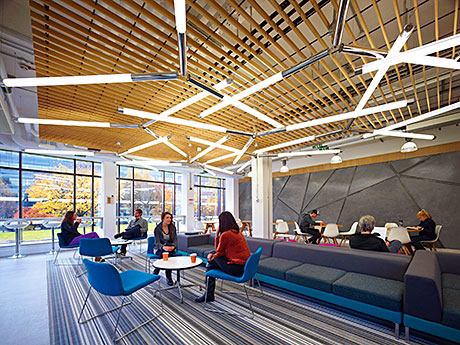Does the quality of the educational environment matter? James Dick is firmly in the ‘yes’ camp.

JUST recall your own experience of life at school and the impact the building fabric and organisational structure had on you and I’m sure you’ll agree.
Most practitioners in the education sector would accept that the creation of an environment conducive to learning will, of itself, create a better chance of students learning than an environment unconducive to learning. Recent years have seen a marked shift from the classical model of cellular classrooms with distinct circulation towards schools, colleges and universities that can provide flexible, multi-use, fluid teaching spaces that take cognisance of the latest trends within the education sector and a blurring of the traditional distinctions between learning and teaching.
A quick glance at our existing educational estate will soon reveal that there are plenty classrooms and lecture theatres; that is, spaces for teaching but notably fewer spaces for self-directed learning. However, the latest educational environments are evolving to reflect the discernible trend away from traditional teaching methodologies towards self-directed learning with the creation of more flexible, fluid spaces that are helping to change the way that students learn through the provision of spaces to learn in, rather than be taught to.
The creation of such sophisticated, multi-use open plan environments offers university estate managers an unprecedented agility with regard to how they use their spaces to fit their changing requirements. Given the present funding predicament that most education establishments find themselves operating within, estates rationalisation – the process of redesigning their existing estate in order to make it more efficient and effective in the way that it works – is typically becoming more relevant than expensive and protracted new building projects. That’s because the utilisation figures that most estates managers are confronting currently are uneconomic in the context of present budget constraints so that consolidation, compaction and seeking to sweat the asset of the built environment is typically the order of the day.
In the recent past, many university estate managers explored the possibility of selling a proportion of their estate for residential or commercial development but with falling land values there is presently little appetite in the market for universities seeking to sell an ageing building stock, effectively leaving them with one course of action: the refurbishment of their existing buildings.
The issue this presents to universities, then, is that their existing buildings are often out of alignment with how they need to be used with regard to teaching space, learning space and office accommodation, which is typically cellular, of the wrong size and inflexible. Refurbishing buildings to make them more spatially efficient through the introduction of such design solutions as hot-desking and open plan teaching spaces, can help university estate managers realise their objective of achieving a more efficient, higher density working environment.
A case in point (pictured top left) is the recent remodelling of the University of Strathclyde’s Lord Hope and Curran buildings in Glasgow city centre for the newly formed Faculty of Humanities and Social Sciences, a project that has delivered high specification office, learning and teaching accommodation supplemented by attendant support and specialist teaching facilities and which forms a benchmark for future developments with regards to space standards, new ways of learning and teaching and space typologies.
Having analysed the way the occupants of the buildings work on a daily basis, the buildings were remodelled to provide a flexibly divided floor plate that can accommodate future change that is more spatially efficient. Each floor of the buildings now has a large open plan work space around the perimeter, ensuring maximum opportunity for daylight and ventilation, with a well-defined core space, with attendant support areas like meeting rooms, break-out hubs, touch-down areas and welfare.
The education sector may be notoriously resistant to change but despite the initial reluctance to these proposals, the university has since expressed delight with the changes and is already realising the benefits to be derived from this new way of teaching and learning.
Such refurbishment projects offer the prospects for realising the benefits to be had from a more efficient and agile estate through the creation of a more engaging environment for students. As the new Faculty of Humanities & Social Sciences illustrates, well-designed refurbished campuses and buildings can create inspirational environments that provide better experiences for staff and students, improve academic performance and raise education standards.
• James Dick leads the Scottish office of architecture practice Sheppard Robson.








